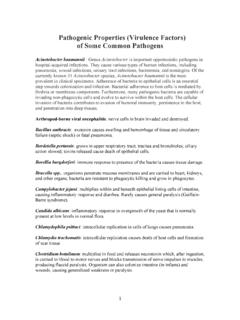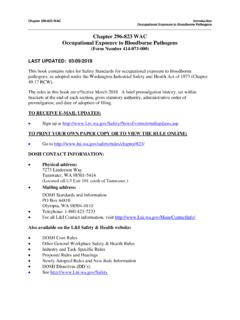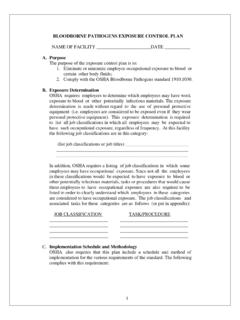Transcription of 2006 05 Standard Precautions - Bloodborne Pathogens …
1 Regulatory: Standard Precautions For healthstream 1 healthstream Regulatory Script Standard Precautions : Bloodborne Pathogens and Other Potentially Infectious Materials VERSION: [May 2006 ] Lesson 1: Introduction Lesson 2: Bloodborne Pathogens Lesson 3: Protecting Yourself Lesson 4: What to Do if You Are Exposed Regulatory: Standard Precautions For healthstream 2 Lesson 1: Introduction 1001 Introduction Welcome to the introductory lesson on Standard Precautions and Bloodborne Pathogens .
2 As your partner, healthstream strives to provide its customers with excellence in regulatory learning solutions. As new guidelines are continually issued by regulatory agencies, we work to update courses, as needed, in a timely manner. Since responsibility for complying with new guidelines remains with your organization, healthstream encourages you to routinely check all relevant regulatory agencies directly for the latest updates for clinical/organizational guidelines. IMAGE: 1 of 4 Regulatory: Standard Precautions For healthstream 3 1002 Course Rationale This course will help you protect: Yourself Your coworkers Your patients Your family You will learn how to: Work safely with blood and body fluids.
3 Protect against exposure to Bloodborne Pathogens . IMAGE: Regulatory: Standard Precautions For healthstream 4 1003 Course Goals After completing this course, you should be able to: Identify important Bloodborne Pathogens and how they are spread. List important safeguards against Bloodborne pathogen exposure. Recognize what to do if you are exposed to a Bloodborne pathogen. NO IMAGE Regulatory: Standard Precautions For healthstream 5 1004 Course Outline This introductory lesson gives the course rationale, goals, and outline.
4 Lesson 2 describes Bloodborne Pathogens . This includes three important Bloodborne diseases and how they are spread. Lesson 3 explains how to use Standard Precautions to protect against exposure to Bloodborne Pathogens . Finally, lesson 4 describes what to do if you are exposed to a Bloodborne pathogen. FLASH ANIMATION: Regulatory: Standard Precautions For healthstream 6 Lesson 2: Bloodborne Pathogens 2001 Introduction & Objectives Welcome to the lesson on Bloodborne Pathogens . After completing this lesson, you should be able to: Define Bloodborne pathogen.
5 List three important Bloodborne diseases. Identify the symptoms of these diseases. Recognize how Bloodborne diseases are spread. FLASH ANIMATION: Regulatory: Standard Precautions For healthstream 7 2002 Bloodborne Pathogens A pathogen is an organism that causes disease. Bloodborne Pathogens are Pathogens carried in a person s bloodstream. They also may be present in other body fluids. IMAGE: Regulatory: Standard Precautions For healthstream 8 2003 Bloodborne Diseases Healthcare workers routinely come into contact with human blood and other body fluids.
6 As a result, healthcare workers are at risk for exposure to Bloodborne Pathogens . This means that healthcare workers need to know: Important Bloodborne diseases Symptoms of these diseases How these diseases are spread IMAGE: Regulatory: Standard Precautions For healthstream 9 2004 Important Bloodborne Pathogens Three important Bloodborne Pathogens are: Hepatitis B virus (HBV) Hepatitis C virus (HCV) Human immunodeficiency virus (HIV) IMAGE: Regulatory: Standard Precautions For healthstream 10 2005 HBV & HCV HBV and HCV both infect the liver.
7 Both of these viruses can cause long-term liver damage. Eighty-five percent (85%) of those infected with HCV become chronic carriers. HBV and HCV infections can be life threatening. IMAGE: Regulatory: Standard Precautions For healthstream 11 2006 HBV & HCV: Vaccines If you are at risk for exposure to blood or OPIM* [glossary] because of your job, your employer must: Offer you the hepatitis B vaccine. Pay for the vaccine. The vaccine is very safe and effective. If you do not want the vaccine, you will need to sign a form.
8 This form states that your employer offered you the vaccine, and you refused. If you change your mind later, you can still receive the vaccine at any time. For more information on the HBV vaccine, contact your supervisor. There is no vaccine for HCV at this time. *Note: You will learn more about OPIM later in the course. See the glossary for a definition. IMAGE: Regulatory: Standard Precautions For healthstream 12 2007 HBV & HCV: Symptoms of Infection Signs and symptoms of HBV and HCV infection can include.
9 Feeling tired Loss of appetite Mild fever Aching muscles or joints Diarrhea Nausea and vomiting Yellowed skin and eyes (jaundice) Dark urine Light colored stools Itching IMAGE: Regulatory: Standard Precautions For healthstream 13 2008 HIV HIV attacks the immune system.
10 This causes the disease known as AIDS. Without a strong, healthy immune system, the body develops many infections and illnesses. These infections and illnesses are the direct cause of death for many AIDS patients. IMAGE: Regulatory: Standard Precautions For healthstream 14 2009 HIV: Symptoms of Infection Early HIV infection may feel like the flu. Other signs and symptoms of HIV infection can include: Swollen lymph nodes Visual changes Diarrhea Night sweats Unexplained weight loss Rash Fatigue Shortness of breath Frequent pneumonias IMAGE: Regulatory: Standard Precautions For healthstream 15 2010 Transmission of Bloodborne Diseases Many patients infected with HBV, HCV, or HIV do not have obvious symptoms.











